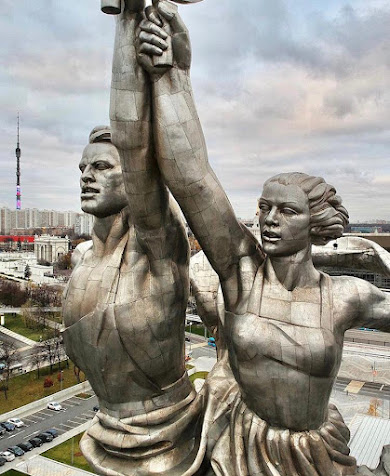In the annals of art history, certain sculptures stand not only as embodiments of aesthetic mastery but also as potent symbols of their time. Vera Mukhina's "Worker and Kolkhoz Woman" is undoubtedly one such monumental creation. Crafted in 1937, amidst the fervor of Soviet ideology and the grandeur of the World's Fair in Paris, this stainless steel colossus has transcended its physical form to become an enduring emblem of an era marked by tumultuous political ideologies, artistic experimentation, and societal aspirations.
Vera Mukhina, a luminary among Soviet sculptors, infused her craftsmanship with a profound commitment to the socialist cause. Born in 1889, Mukhina's artistic journey paralleled the tumultuous trajectory of Russia's socio-political landscape. Amidst the tumult of revolution and the utopian fervor of the early Soviet years, she emerged as a leading proponent of socialist realism—an artistic doctrine that sought to intertwine aesthetic expression with the ideological imperatives of the Communist state.
Standing at a towering height of 24.5 meters, Mukhina's magnum opus commands attention and reverence. Crafted from stainless steel—a material emblematic of modernity and industrial progress—the sculpture embodies the spirit of an era poised between tradition and transformation. Its colossal dimensions, juxtaposed against the delicate grace of its figures, evoke a sense of awe and reverence, inviting viewers to contemplate the symbiotic relationship between humanity and industry, between labor and liberation.
At its core, "Worker and Kolkhoz Woman" is a celebration of the proletariat—the unsung heroes of Soviet society. The central figures, a sturdy male worker and a resolute female collective farm laborer, stand united in purpose, their outstretched arms bearing the tools of their trade—a hammer and sickle, the iconic emblems of proletarian solidarity and revolutionary zeal. Through Mukhina's skilled hands, these archetypal figures transcend mere representation to embody the aspirations and struggles of an entire class—a class poised on the precipice of history, striving to forge a new world amidst the ashes of the old.
Yet, beneath its veneer of ideological fervor, Mukhina's sculpture exudes a timeless aesthetic appeal—a fusion of socialist realism and Art Deco sensibilities. The sleek contours of the figures, the dynamic interplay of light and shadow, the sense of movement frozen in time—all bear testament to Mukhina's mastery of form and composition. In her hands, the mundane is transfigured into the sublime, the prosaic into the profound, inviting viewers to transcend the confines of ideology and immerse themselves in the sheer beauty of human expression.
Historically, "Worker and Kolkhoz Woman" occupies a pivotal place in the pantheon of Soviet art and propaganda. Conceived at a time when the Soviet Union stood on the cusp of industrialization and collectivization, Mukhina's sculpture served as a potent symbol of the regime's aspirations for a new socialist utopia. Its prominent display at the World's Fair in Paris—an event designed to showcase the achievements of Soviet socialism to the world—underscored its significance as both a work of art and a political statement.
In the decades that followed, Mukhina's sculpture continued to exert its influence, albeit in evolving contexts. From its relocation to Moscow's Russian Exhibition Centre to its adoption as the emblem of the Mosfilm cinema studio, "Worker and Kolkhoz Woman" remained a fixture of Soviet iconography, a touchstone for artists, propagandists, and revolutionaries alike.
Today, Mukhina's masterpiece endures as a testament to the resilience of the human spirit in the face of adversity. Despite the collapse of the Soviet Union and the ideological battles of the twentieth century, "Worker and Kolkhoz Woman" continues to inspire and provoke, its monumental presence a reminder of the enduring power of art to transcend time and space, ideology and dogma.
To encapsulate, Vera Mukhina's 'Worker and Kolkhoz Woman' emerges as a monumental testament to the enduring spirit of humanity, beckoning us to delve deeper into the intertwining narratives of art, ideology, and historical resonance. Through its fusion of socialist realism and aesthetic innovation, Mukhina's sculpture remains as relevant today as it was nearly a century ago, inviting us to contemplate the timeless ideals of solidarity, liberation, and human dignity that it so brilliantly embodies.
------------------------------------------------------------------------------------
This work is licensed under a Creative Commons Attribution-No Derivative Works 3.0 Unported License.









.png)


.png)



No comments:
Post a Comment